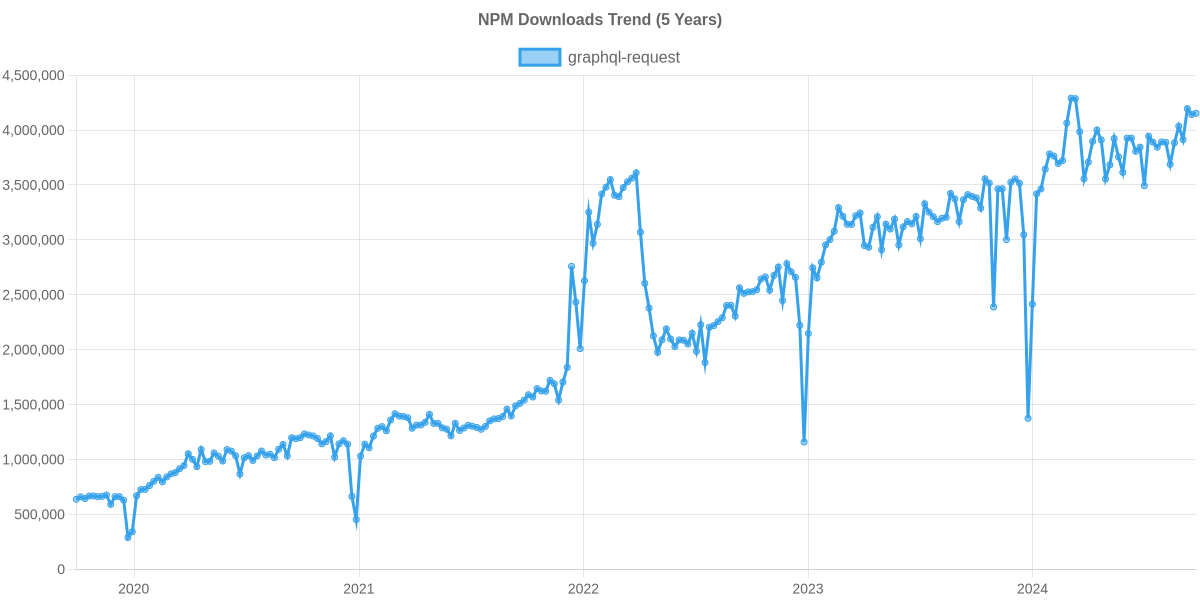Data Fetching
- graphql-request:
GraphQL Request offers a minimalistic API for making GraphQL queries and mutations. It allows developers to send requests with a simple function call, making it easy to integrate into any JavaScript project. However, it lacks advanced features like caching and state management, which may require additional implementation.
- apollo-client:
Apollo Client provides a powerful and flexible API for fetching data from GraphQL endpoints. It supports query batching, pagination, and automatic caching of results, which optimizes network requests and improves performance. Apollo's caching mechanism allows for efficient data retrieval and minimizes redundant requests, making it suitable for complex applications.
- urql:
Urql provides a flexible and efficient way to fetch data from GraphQL APIs. It supports query and mutation execution with a focus on simplicity and performance. Urql's architecture allows for easy customization of the data fetching process, making it a good choice for projects that require specific optimizations.
- react-apollo:
React Apollo integrates Apollo Client with React, providing hooks and components that simplify data fetching within React components. It allows developers to easily manage loading states, error handling, and data updates directly in their UI components, enhancing the developer experience when working with GraphQL.
State Management
- graphql-request:
GraphQL Request does not provide any state management features. It is solely focused on making GraphQL requests, meaning developers will need to implement their own state management solutions if needed, which can increase complexity in larger applications.
- apollo-client:
Apollo Client offers built-in state management capabilities, allowing developers to manage both remote and local state in a unified way. It enables optimistic UI updates and provides tools for managing local cache, making it ideal for applications that require complex state interactions.
- urql:
Urql allows for local state management through its built-in features, but it is more lightweight compared to Apollo Client. Developers can manage local state using Urql's cache and custom hooks, providing flexibility in how state is handled in the application.
- react-apollo:
React Apollo leverages Apollo Client's state management capabilities, allowing developers to manage local state alongside remote data seamlessly. It provides hooks for managing local state and integrating it with the GraphQL data layer, streamlining the development process in React applications.
Learning Curve
- graphql-request:
GraphQL Request has a very low learning curve, as it provides a simple API for making requests. Developers can quickly get started without needing to understand complex concepts, making it an excellent choice for beginners or small projects.
- apollo-client:
Apollo Client has a moderate learning curve due to its extensive features and concepts such as caching, state management, and subscriptions. Developers may need to invest time in understanding these concepts to fully leverage Apollo's capabilities, especially in larger applications.
- urql:
Urql has a relatively low learning curve, especially for developers familiar with React. Its modular design allows developers to learn and implement features incrementally, making it accessible for those who want a flexible solution without overwhelming complexity.
- react-apollo:
React Apollo has a moderate learning curve, particularly for developers already familiar with React. Understanding how to use hooks and manage data within React components may take some time, but the integration with Apollo Client simplifies the process of working with GraphQL in React.
Extensibility
- graphql-request:
GraphQL Request is not designed for extensibility. Its minimalistic approach means that it lacks built-in features for customization, which may limit its use in more complex scenarios where additional functionality is required.
- apollo-client:
Apollo Client is highly extensible, allowing developers to create custom links, middleware, and cache implementations. This flexibility enables developers to tailor the client to their specific needs and integrate it with other libraries and frameworks easily.
- urql:
Urql is designed with extensibility in mind, allowing developers to create custom exchanges to modify the behavior of the client. This modular approach enables developers to add or remove features as needed, making it a versatile choice for various use cases.
- react-apollo:
React Apollo is extensible through its integration with Apollo Client, allowing developers to create custom hooks and components that can enhance functionality. However, it is primarily focused on the React ecosystem, which may limit its use in non-React applications.
Performance
- graphql-request:
GraphQL Request is lightweight and has minimal overhead, making it performant for simple use cases. However, it does not include built-in caching or optimizations, which may lead to increased network requests in larger applications.
- apollo-client:
Apollo Client is optimized for performance with features like intelligent caching and query batching, which reduce the number of network requests and improve loading times. However, its extensive features can lead to increased bundle size, which may impact performance in smaller applications.
- urql:
Urql is designed to be lightweight and performant, with a focus on minimizing the overhead of data fetching. Its customizable architecture allows developers to optimize performance based on their specific requirements, making it a good choice for applications that prioritize speed.
- react-apollo:
React Apollo benefits from Apollo Client's performance optimizations, including caching and batching. It is designed to minimize unnecessary re-renders and efficiently manage data updates, making it suitable for performance-sensitive applications.













